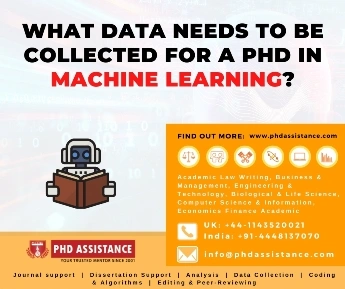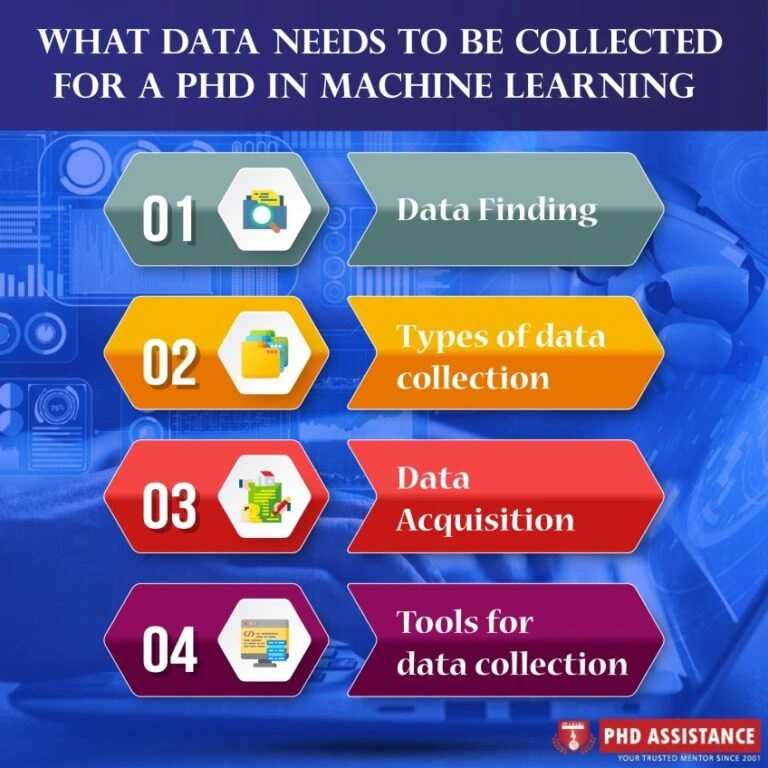What data needs to be collected for a PhD in Machine Learning?
In-Brief:
A PhD in machine learning involves exploring and developing a precise subject matter among many machine learning subfields. In the AI industry, a PhD is appreciated as an outstanding achievement. Development in automated data analysis techniques and decision-making needs research work in machine learning algorithms and foundations, statistics, complexity theory, optimization, data mining, etc. This blog discusses the various data collection methods in the machine learning research field.

Introduction:
If humans want the machines to act and them, we have to see how humans learned to walk and talk initially. Similarly, for a machine to enact like human beings, data is required, deprived of data, no machine learning.
Data collection is collecting and measuring information from many different sources. The data need to be developed for Artificial Intelligence (AI) and Machine Learning solutions. It must be collected and stored in a way that solves the problem.
Machine learning is heavily used for business intelligence and analytics, effective web search, robotics, smart cities, and understanding the human genome. But there is a significant challenge for society to use the vast quantities of stored data, and due to this, science and technology have to attain huge investment in computerization and Data Collection.
- Data Finding: Data findings can be viewed as two steps.
i)The created data must be indexed and published for sharing.
- ii) Some others can search the datasets for their machine learning tasks.
Research needs:
A PhD in machine learning involves exploring and developing a precise subject matter among many machine learning subfields. In the AI industry, a PhD is appreciated as an outstanding achievement. Development in the automated Techniques for Data Analysis and decision making needs research work in machine learning algorithms and foundations, statistics, complexity theory, optimization, data mining, etc.
- Types of data collection
Data can be considered into two kinds
Structured Data:
It refers to well-defined types of data stored in search-friendly databases such as dates, numbers, strings, etc.
Unstructured Data:
It is everything can be collected-but not search-friendly, such as emails, Text files, Media files (music, videos, photos)
- Data Acquisition
The aim is to discover datasets that are used to train machine learning models. There are broadly three approaches in the literature:
Data Discovery is required when one needs to share or search for new datasets and become necessary and available on the Website and corporate data lakes.
Data Augmentation is counterparts data discovery that existing datasets are improved by adding additional data externally.
Data Generation is used when there is no available external dataset, but it can generate crowdsourced or synthetic datasets instead. The different methods are classified in Table 1.
Table 1: Types of data acquisition techniques. Some of them can be used together

In Figure 1, an example of data collection based on the industry in an intelligent factory application [1].
Fig. 1: A high-level research of data collection for machine learning.
- Tools for data collection
A data collection tools should be userfriendly, support all file types and functionalities, and protect data integrity. Some of the best Data Collection tools for Machine Learning projects are given below.
- i) Raw Data Collection
The problem in many data science projects is finding relevant, raw data. The tools which allow users for fast access to substantial raw data are,
- a) Data Scraping Tools
It describes the automated, programmatic usage of an application to mine data or performs the task that users would perform manually, like social media posts or images.
Tools to extract data from the web are
- Octoparse: A web scraping is a non-coding tool that used to get public data
- Mozenda: A tool that doesn’t require any scripts or developers to extract unstructured web data
- b) Synthetic Data Generator
This tool can also be generated by programs to get large sample sizes of data. This data is used in training neural networks.
Few tools for generating synthetic datasets are
pydbgen: It is a Python library that is used to produce a vast synthetic database as stated by the user.
Mockaroo: It is a data generator tool that allows users to create or custom CSV, SQL, JSOn and Excel datasets to test and trial software.
- c) Data Augmentation Tools
Data augmentation, in some cases, is used to increase the size of an existing dataset despite gathering additional data. For example, an image dataset is augmented by cropping, rotating, or changing the original document’s lighting effects.
OpenCV: In this Python library, image augmentation functions are available. For example, features like bounding boxes, cropping, scaling, rotation, blur, filters, translation, and so on.
scikit-image: This tool is also a collection of algorithms for image processing which are available for free of cost and restriction. It also has provision to convert from one colour space to another space, erosion and dilation, resizing, rotating, filters, and so on.
Future Scope
As machine learning becomes more widely used, it becomes more important to acquire large amounts of data and label data, especially for state-of-the-art neural networks. If the current state of machine learning is available, the future of machine learning has high opportunities for technologists. Some of the use evolving today that enlarge the future scope are:
- Optimizing Operations
- Safer Healthcare
- Fraud Prevention
- Mass Personalization
References
[1] Y. Roh, G. Heo and S. E. Whang, “A Survey on Data Collection for Machine Learning: A Big Data – AI Integration Perspective,” in IEEE Transactions on Knowledge and Data Engineering, vol. 33, no. 4, pp. 1328-1347, 1 April 2021, doi: 10.1109/TKDE.2019.2946162.
[2] Makarious, Mary B., et al. “GenoML: Automated Machine Learning for Genomics” arXiv:2103.03221, 2021.
[3] Joseph F. Hair Jr. & Marko Sarstedt (2021) Data, measurement, and causal inferences in machine learning: opportunities and challenges for marketing, Journal of Marketing Theory and Practice, 29:1, 65-77, DOI: 10.1080/10696679.2020.1860683



